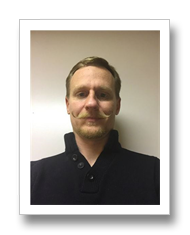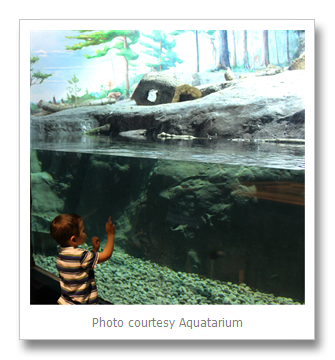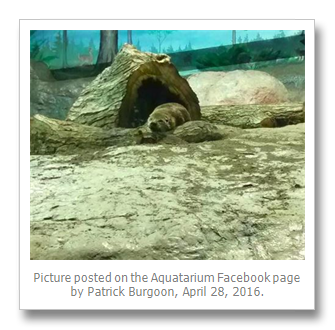Editor’s Note: On my first visit to the Aquatarium I met Thomas Harder, although I had already read his material on the Aquatarium website. I asked him if I could publish his introduction, and he quickly agreed. I suggest we all keep checking the official website – as there will be more to learn about the wildlife who now call the Aquatarium home.
|
Hi. I’m Thomas Harder, and I am part of the Aquatarium’s Animal Husbandry team. I’ve worked professionally in this field for nearly 20 years, and have a background in biology, chemistry, life support and exhibit design and maintenance. I’ve worked in a number of Aquariums in the United States throughout my career, building exhibits, taking care of animals and educating people about science and nature. I love to visit zoos, science centers, nature museums, and children’s museums. So, every time I travel somewhere I make sure to visit as many of these places as I can.

I generally spend most of my time at these facilities, looking at how things are constructed, how the animals and people interact, and how things work, rather than just enjoying the animals or exhibits themselves. I’m a little crazy, but I love what I do… I guess that is why I moved with my family to Canada, to be a part of this facility, three years ago. And, as much as I have enjoyed designing, building, and ultimately starting up the exhibits, I am excited to be able to focus more of my time on my job as Director of Animal Husbandry.
Animal Husbandry
What is Animal Husbandry? Animal husbandry is defined as the process of caring for and breeding of different kinds of animals. The job extends beyond just feeding and scooping poop, if that is what you’re thinking, though.
We have to make sure that the habitats and equipment are suitable for the animals and we have to look after their mental and physical well-being. We also have a duty to educate people about the animals. Generally, what we do is not as simple as keeping a dog or cat. We have to provide everything these animals need, including a place to live, and I am not Mother Nature!
It can be a challenge to reproduce “the wild.” Plus, there’s not always a simple way to know what an animal needs. That being said, having experience with the design and construction, as well as methods and procedures from many facilities and exhibits, I have a good base of knowledge to draw from.
Now it’s your turn to get some insight into my job, and the animals we care for here, by regularly featuring one of the species in the Aquatarium. I hope to tell a bit about what kind of animal they are and a bit about the type of care that is required, to ensure that they have a happy home and life. So let’s kick this off, talking about the playful River Otter.
River Otters
River Otters are semi-aquatic mammals found in and around waterways and coasts. River Otters actually spend proportionately more time on land than in the water. The water is very important for an Otter though. They generally use the water to hunt fish or to play. They don’t actually just “live” in the water. They den on land, generally eat on land, and defecate on the land. Our habitat in fact has been designed with more land mass than water to allow for those behaviors.
An adult River Otter can weigh between 5 and 14 kg and are protected and insulated, by a thick, water-repellent coat of fur. The oils in the fur of the otter are actually easily damaged or stripped off by certain pollutants, and even naturally occurring chemicals, found in the bark and leaves of certain trees. We must be careful about the types of materials we put into the habitat, with the otters, as we could cause problems with this oily coat.
The River Otter is a member of the weasel family and is omnivorous. River otters have a mouth full of teeth that allow them to eat everything, from nuts and berries to frogs, mice, snakes and fish. They are awesome hunters. That means to us, as the husbandry team, that we must be careful when working with the otters, as they could harm us. We have setup a network of areas the otters can go, and gates to separate us, while we work on their dens, or clean their habitat. We also must feed a varied diet of proteins, as well as veggies and fruits to our otters.

Otters typically have about a 10-year lifespan in the wild, but in captivity, they can live up to 15 years. This is generally because they are protected from potential predators and pollutants, and they always have enough to eat! Did you know that in the wild, River Otters are hunted by wolves, bobcats, bears and other large mammals? We provide a regular varied diet of high quality foods, supplements and vitamins, as well as veterinary care for all of our animals. As tough as River Otters are, they can actually be sensitive to environmental pollution, in both their habitat and food supply. To overcome these problems here, we have designed a water filtration system for the otters that keeps their habitat clean and clear, free of pollutants.

Because of increased development and ongoing damages to otter habitats, River Otters are not nearly as common in the wild – including the St. Lawrence River – as they once were. As such, River Otters are on the list of animals considered to be threatened, or endangered, in many parts of North America. River Otters play an important role in the food chain of the 1000 Islands, helping to keep populations of rodents, birds, snakes and lizards in check.
Check out our blog on River Otters, for more information about these interesting critters. I look forward to welcoming you to the Aquatarium. I will be the one with the handlebar mustache, talking to the animals.
By Thomas Harder
Thomas Harder is the Aquatics Director for the new Brockville Aquatarium; with 15 years of experience, organizing, maintaining, and developing educational aquatic habitats and facilities for leading institutions all over North America. He moved his family from Los Angeles, CA. We take this opportunity to welcome Thomas, as an aquarist, to Eastern Ontario.